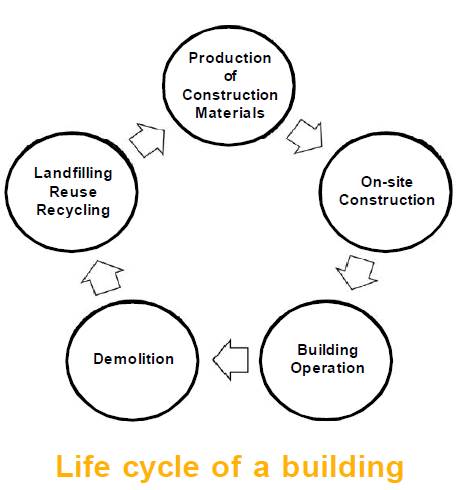|
Built
Environment Sustainability: T he built environment uses significant amount of materials and energy in the global economy. The operational phase represents about 80-90% of the life cycle energy for buildings with centralised air-conditioning systems. For buildings that are naturally ventilated or partially air-conditioned1, the energy used for production of materials and on-site construction is as important as operation energy for the buildings. In such cases, initiatives toward sustainable built environment should focus on improving the energy efficiency of construction materials and on-site construction processes in addition to building operational energy efficiency.This requires development of a comprehensive directory of embodied energy of construction materials and energy use for on-site activities in India, which in turn requires availability of a simplified protocol/template for measuring embodied energy of construction materials, compilation of energy use data from material manufacturers and creation of a positive eco-system through government policies to enable seamless interaction among various stakeholders 2.Sustainability indicators are one such tool.
Composite sustainability Life Cycle Assessment (LCA) consists of four major steps namely: • Goal and scope definition • Life cycle inventory quantification • Impact assessment • Improvement analysis The scope of several studies reported in the built environment literature is limited to inventory quantification. This is due to the fact that it is possible to make useful conclusions using the inventory data itself, for example, energy footprint (MJ/sq.m.) and carbon footprint (kg CO2(e) / sq.m.). Moreover, the calculation procedures used for impact assessment vary from one tool to another based on several parameters. LCA software tools used in industry practice like SimaPro (Netherlands), GaBi (Germany) and Athena (Canada) provide a wide range of functionalities for environmental impact assessment and comparison of alternate scenarios. However, the user should exercise caution in interpreting the findings for Indian case studies due to the differences in the underlying inventory data. Successful application of LCA requires creating awareness among the stakeholders; reducing the subjectivity in defining the boundary conditions; appreciating the effect of technology, location, time and fuel mix on LCA results; ensuring the quality of data and defining goal and scope so as to optimise the time, cost and resources needed for completing the LCA study. Future initiatives towards sustainable built environment will need to focus on quantifying material, energy and waste flows across geographies; relationships between design, service life and resource use as well as social aspects of built environment sustainability 4. qSivakumar Palaniappan References 2 Anna George Nellickal a-nd Sivakumar Palaniappan (2015) Built Environment Sustainability: Review of Key Concepts, NICMAR Journal of Construction Management, 30(1), 5-18. 3 Guggemos, A. & Horvath, A. (2005) "Comparison of environmental effects of steel- and concrete-framed buildings", ASCE Journal of Infrastructure Systems, 11(2), 93-101. 4 Horvath, A. (2004) "Construction Materials and the Environment", Annual Review of Environment and Resources, 29, 181-204. |
 indicators are derived from multiple simple
indicators like embodied energy, operating energy, durability and carbon
emissions. Ecological footprint, eco-labeling and eco-efficiency are
examples of composite indicators. Environmental per-formance assessment
based on one or two life cycle phases of a building (or a product or
material) may lead to biased conclusions. For example, consider the
performance of a steel-framed building and a concrete-framed building.
Steel-framed building is more energy intensive during the material
manufacturing phase. It requires relatively less energy during the
on-site construction and end-of-service life phases. Concrete-framed
building is more energy intensive during the on-site construction and
the end-of-service life phases. However, the embodied energy of concrete
(0.6 to 1.4 MJ/kg) is significantly less compared to steel (10 to 50 MJ/kg).
It is reported that the performance of both buildings is comparable
considering the entire life cycle
indicators are derived from multiple simple
indicators like embodied energy, operating energy, durability and carbon
emissions. Ecological footprint, eco-labeling and eco-efficiency are
examples of composite indicators. Environmental per-formance assessment
based on one or two life cycle phases of a building (or a product or
material) may lead to biased conclusions. For example, consider the
performance of a steel-framed building and a concrete-framed building.
Steel-framed building is more energy intensive during the material
manufacturing phase. It requires relatively less energy during the
on-site construction and end-of-service life phases. Concrete-framed
building is more energy intensive during the on-site construction and
the end-of-service life phases. However, the embodied energy of concrete
(0.6 to 1.4 MJ/kg) is significantly less compared to steel (10 to 50 MJ/kg).
It is reported that the performance of both buildings is comparable
considering the entire life cycle